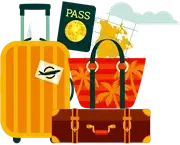
We make it possible for you to go on an adventure of a lifetime with our comprehensive guide to the best Kenyan safari adventures. We ensure you experience a perfect balance of comfort, excitement, and responsible tourism while you explore Kenya's beauty and breathtaking landscapes.
 Plan an amazing Kenyan adventure with our expertly curated safari and tour guides. From luxury sports safaris to personalized itineraries and exclusive cultural experiences, we offer perfect, eco-friendly packages through Kenya's best destinations.
Plan an amazing Kenyan adventure with our expertly curated safari and tour guides. From luxury sports safaris to personalized itineraries and exclusive cultural experiences, we offer perfect, eco-friendly packages through Kenya's best destinations.
- Expertly Curated Safari Guides: Experience the best safari parks, luxury lodges, and hidden gems tailored to your preferences for special adventures.
- Access to Exclusive Experiences: Gain priority access to luxury sports safaris, private conservancies, and authentic cultural encounters.
- Ideal Travel Support: From visa guidance to 24/7 on-ground assistance, we ensure you understand every detail, ensuring a hassle-free and luxurious safari experience.
Rare Colobus Monkeys and Nature Walks in Ruma National Park
Ruma National Park, a hidden gem in Kenya, is a sanctuary of unspoiled wilderness that offers a haven for rare and endangered species. It is the only place in Kenya where the rare Colobus monkey thrives in its natural habitat, making it a prime destination for wildlife conservation and ecotourism. The park is characterized by a breathtaking landscape of vast woodlands, undulating hills, open savannahs, and riverine forests, creating a dynamic and diverse ecosystem teeming with wildlife. Beyond its reputation as a refuge for the Colobus monkey, Ruma National Park is home to a variety of species, including Rothschild’s giraffes, leopards, buffaloes, and an array of birdlife such as the globally threatened blue swallow. The park provides exceptional opportunities for wildlife photography, birdwatching, and immersive nature walks. The pristine environment and the presence of rare species make Ruma an essential stop for nature enthusiasts, conservationists, and adventure seekers alike. The park’s remote location and relatively low tourist numbers allow visitors to experience the beauty of nature in solitude, away from the crowded safari circuits. A visit to Ruma National Park is an opportunity to escape urban life and reconnect with the tranquility of nature. Whether exploring the shaded canopies where Colobus monkeys gracefully move from tree to tree, walking through lush forests, or traversing the golden plains where antelope graze, Ruma National Park offers a peaceful and immersive experience unlike any other. For those looking to enhance their visit, guided nature walks led by experienced rangers and naturalists provide deeper insights into the park’s rich biodiversity and unique ecosystems. The knowledge imparted by these experts enhances the experience, making every walk a fascinating journey through Kenya’s lesser-known but equally magnificent landscapes. Ruma National Park is a must-visit for anyone seeking a deeper connection with nature and a glimpse into Kenya’s rich and diverse wildlife heritage.
What Makes Ruma National Park Special?
 Ruma National Park is one of Kenya’s most unique and breathtaking wildlife destinations, offering visitors an experience that blends conservation, adventure, and tranquility. Unlike the more famous parks such as the Maasai Mara and Amboseli, Ruma remains relatively untouched, providing an exclusive and intimate safari experience. The park’s remote location ensures fewer visitors, allowing for serene wildlife viewing and an opportunity to connect deeply with nature. One of the park’s most distinctive features is its status as the only protected area in Kenya where the endangered Colobus monkey can be found. These rare primates, with their striking black-and-white coats and acrobatic leaps through the treetops, make Ruma a must-visit destination for primate lovers. Beyond the Colobus monkey, the park is a sanctuary for the critically endangered blue swallow, a migratory bird that relies on Ruma’s wetlands as a crucial stopover during its long journeys. In addition to its rare wildlife, Ruma boasts a diverse and scenic landscape, ranging from rolling savannahs and dense forests to rocky outcrops and winding rivers. This variety of habitats supports a wide range of wildlife, including Rothschild’s giraffes, leopards, African buffalo, and antelope species such as the oribi. Birdwatchers will find Ruma especially rewarding, as the park is home to over 400 species of birds, making it one of Kenya’s top birding destinations. The park also offers exceptional hiking and nature walk experiences providing visitors an opportunity for hiking and trekking experiences in Kenya. Guided nature walks provide visitors with an up-close look at Ruma’s flora and fauna, making it an excellent choice for families, photographers, and nature lovers alike. Whether you are exploring the shaded canopies of the Nyatike Hills, following the trails along the park’s rivers, or simply taking in the expansive golden plains, Ruma National Park guarantees a peaceful and unforgettable adventure.
Ruma National Park is one of Kenya’s most unique and breathtaking wildlife destinations, offering visitors an experience that blends conservation, adventure, and tranquility. Unlike the more famous parks such as the Maasai Mara and Amboseli, Ruma remains relatively untouched, providing an exclusive and intimate safari experience. The park’s remote location ensures fewer visitors, allowing for serene wildlife viewing and an opportunity to connect deeply with nature. One of the park’s most distinctive features is its status as the only protected area in Kenya where the endangered Colobus monkey can be found. These rare primates, with their striking black-and-white coats and acrobatic leaps through the treetops, make Ruma a must-visit destination for primate lovers. Beyond the Colobus monkey, the park is a sanctuary for the critically endangered blue swallow, a migratory bird that relies on Ruma’s wetlands as a crucial stopover during its long journeys. In addition to its rare wildlife, Ruma boasts a diverse and scenic landscape, ranging from rolling savannahs and dense forests to rocky outcrops and winding rivers. This variety of habitats supports a wide range of wildlife, including Rothschild’s giraffes, leopards, African buffalo, and antelope species such as the oribi. Birdwatchers will find Ruma especially rewarding, as the park is home to over 400 species of birds, making it one of Kenya’s top birding destinations. The park also offers exceptional hiking and nature walk experiences providing visitors an opportunity for hiking and trekking experiences in Kenya. Guided nature walks provide visitors with an up-close look at Ruma’s flora and fauna, making it an excellent choice for families, photographers, and nature lovers alike. Whether you are exploring the shaded canopies of the Nyatike Hills, following the trails along the park’s rivers, or simply taking in the expansive golden plains, Ruma National Park guarantees a peaceful and unforgettable adventure.
- Exclusive Colobus Monkey Sightings: As the only protected area in Kenya where the Colobus monkey thrives, Ruma National Park offers unparalleled opportunities to observe these rare primates in their natural habitat. Their striking black-and-white coats and graceful leaps from tree to tree make them a mesmerizing sight for visitors.
- Diverse Bird Species, Including the Blue Swallow: The park is a birdwatcher’s paradise, home to over 400 bird species, including the rare and endangered blue swallow. These migratory birds, which travel thousands of kilometers, can be seen resting in the park’s lush grasslands and wetlands, making Ruma a key stopover point for avian enthusiasts.
- Unspoiled Nature Trails and Hiking Routes: Ruma National Park features well-preserved nature trails that wind through its diverse landscapes, from dense forests to rolling savannahs. These trails offer an immersive way to experience the park’s flora and fauna, with experienced guides providing fascinating insights into the local ecosystem.
Are Guided Nature Walks Available?
Yes, professional guides, including those from Homejoy Safari Adventures, lead small-group nature walks, offering an immersive experience into Ruma National Park’s rich biodiversity. These guided walks provide detailed insights into the park’s flora, fauna, and ecosystems, making them ideal for wildlife enthusiasts, birdwatchers, and nature lovers. The guides use their expertise to help visitors spot rare species like the Colobus monkey, Rothschild’s giraffe, and various birds, while also explaining the intricate relationships between different plant and animal species. Guided nature walks cater to different fitness levels, with shorter, more relaxed trails for families and beginners, as well as longer, more challenging treks for avid adventurers. Similar to Kakamega nature walks for family, these walks are family-friendly, allowing children to explore nature in a safe environment while learning about conservation. The gentle terrain of some trails makes it easy for visitors of all ages to participate, ensuring an enjoyable experience for families and groups. For safety and optimal experience, guided walks are typically conducted in the early morning or late afternoon when temperatures are cooler and wildlife activity is at its peak. In addition to wildlife viewing, the guided walks also highlight medicinal plants, indigenous trees, and the cultural significance of the region’s landscapes. Visitors can learn about the traditional uses of various plant species and how local communities interact with nature for sustenance and healing. Whether you’re looking for an informative and leisurely stroll or an adventurous trek, the guided nature walks at Ruma National Park provide an unforgettable way to explore Kenya’s unspoiled wilderness.
What Other Wildlife Can Be Spotted in Ruma National Park?
Ruma National Park is home to an impressive diversity of wildlife, making it one of Kenya’s most underrated safari destinations. While the rare Colobus monkey is the park’s main attraction, many other fascinating species can be spotted within its diverse landscapes and Homejoy Safari Adventures provide packages to Ruma. From large herbivores grazing on the savannah to elusive predators lurking in the rocky outcrops, Ruma offers a remarkable variety of fauna for nature enthusiasts and wildlife photographers alike.
- Rothschild’s Giraffe:Ruma National Park is one of the few protected areas in Kenya where the endangered Rothschild’s giraffe can be seen. These elegant creatures, recognizable by their distinctively lighter coat and lack of markings below the knees, are often found browsing acacia trees in the park’s expansive grasslands. Early morning and late afternoon provide the best chances of sighting these gentle giants as they move gracefully in search of food.
- Leopard: The elusive leopard is another highlight of Ruma National Park, although sightings require patience and a keen eye. These solitary predators are most commonly spotted in rocky outcrops or dense bushland where they blend seamlessly with their surroundings. Dusk and dawn are the ideal times to observe leopards, as they become more active during these cooler hours, often hunting or patrolling their territory.
- African Buffalo:Herds of African buffalo roam the park’s grasslands and wetlands, often congregating near water sources to drink and cool off. These formidable creatures play a vital role in the park’s ecosystem and can be observed throughout the day. Buffaloes are known for their unpredictable behavior, making it essential for visitors to maintain a safe distance while observing them in their natural habitat.
- Oribi Antelope: Among the lesser-known but equally fascinating species in Ruma National Park is the oribi antelope. These small, graceful antelopes prefer open grasslands where they can use their incredible speed and agility to escape predators. Oribis are most active in the early morning and late afternoon, making those times ideal for spotting them in the park’s vast plains.
- Blue Swallow: Bird enthusiasts will be delighted by the presence of the globally threatened blue swallow, a migratory bird that finds sanctuary in Ruma’s wetlands and open fields. These strikingly beautiful birds travel long distances across Africa and rely on the park’s healthy ecosystem as a crucial stopover during their migrations. The best time to see blue swallows is between April and October when they arrive in Kenya before continuing their journey.
Ruma National Park’s biodiversity extends beyond these species, with other wildlife such as baboons, hyenas, and a variety of reptiles also thriving within its landscapes. Whether tracking large mammals, admiring rare birds, or exploring the park’s hidden gems, every visit to Ruma promises an unforgettable encounter with Kenya’s wild beauty.
Where Can I See Rare Colobus Monkeys in Kenya?
Colobus monkeys are primarily found in the Nyatike and Gwassi Hills within Ruma National Park, where the dense, untouched forest canopy provides an ideal habitat for them. These highly agile primates prefer the upper layers of the forest, leaping effortlessly between branches in search of leaves, fruits, and flowers. Early morning and late afternoon are the best times to spot them, as they are most active during these cooler periods of the day. Guided nature walks through these hilly terrains offer the best chance of encountering Colobus monkeys, along with other fascinating wildlife that shares their ecosystem. Other destinations in Kenya where Colobus monkeys can be spotted include:
-
Kakamega Forest. A tropical rainforest with one of the highest densities of Colobus monkeys, best explored through guided hikes along lush trails.
-
Aberdare National Park. Home to diverse forested landscapes where Colobus monkeys thrive, often seen near waterfalls and along nature trails.
-
Mount Kenya Forest Reserve. Offers high-altitude sightings of Colobus monkeys in dense canopies along with other unique mountain wildlife.
-
Shimba Hills National Reserve. A coastal forest ecosystem where Colobus monkeys can be observed moving gracefully through the treetops.
-
Arabuko Sokoke Forest. A biodiversity hotspot along the Kenyan coast, hosting not just Colobus monkeys but also rare bird species and butterflies.
Frequently Asked Questions (FAQs) About Ruma National Park
1. Where is Ruma National Park located? Ruma National Park is located in Homa Bay County, in western Kenya, near the shores of Lake Victoria. It is approximately 140 kilometers from Kisumu and 425 kilometers from Nairobi, making it a great off-the-beaten-path destination for nature lovers.
2. What is Ruma National Park famous for? Ruma National Park is best known for being the only protected area in Kenya where the rare Colobus monkey thrives. It is also home to the endangered Rothschild’s giraffe, the globally threatened blue swallow, and a diverse range of bird and mammal species.
3. What are the best activities to do in Ruma National Park? Visitors to Ruma National Park can enjoy:
- Wildlife viewing: Spot rare species like the Colobus monkey, leopards, Rothschild’s giraffes, and oribi antelopes.
- Birdwatching: Home to over 400 bird species, including the migratory blue swallow.
- Guided nature walks: Explore the park’s landscapes on foot with expert guides.
- Photography safaris: Capture stunning landscapes and unique wildlife.
- Hiking and exploration :Traverse scenic trails with breathtaking views.
4. When is the best time to visit Ruma National Park? The best time to visit Ruma National Park is during the dry seasons, from June to October and January to March. During this period, wildlife is easier to spot as animals gather around water sources, and the roads and trails are more accessible.
5. Are guided tours available in Ruma National Park? Yes, guided tours are available through reputable tour companies like Homejoy Safari Adventures. These tours provide an immersive experience with knowledgeable guides who share insights into the park’s history, wildlife, and conservation efforts.
6. Is Ruma National Park family-friendly? Absolutely! The park is a great destination for families, offering:
-
Safe and scenic nature walks suitable for children.
-
A relaxed and less crowded environment compared to major safari parks.
-
Educational experiences about conservation and wildlife.
-
Opportunities for picnicking and sightseeing in a tranquil setting.
7. How do I get to Ruma National Park? Visitors can access Ruma National Park via road from Kisumu, Homa Bay, or Nairobi. The nearest town is Homa Bay, where visitors can arrange transport to the park’s main gate. Private vehicles and guided tour operators provide the most convenient travel options.
8. What should I bring for my trip to Ruma National Park? To fully enjoy your visit, consider packing:
-
Comfortable walking shoes and lightweight clothing.
-
A camera or binoculars for wildlife spotting.
-
Sunscreen, a hat, and insect repellent.
-
Snacks and drinking water for longer excursions.
-
A field guidebook or app for identifying birds and animals.
9. Can I camp inside Ruma National Park? Yes, Ruma National Park has designated camping areas for visitors who wish to experience the wild under the stars. It is recommended to bring your own camping gear and confirm availability with Kenya Wildlife Service (KWS) in advance.
10. What makes Ruma National Park a must-visit destination? Ruma National Park is a hidden treasure offering:
-
Unique and rare wildlife species in their natural habitat.
-
Stunning landscapes with forests, savannahs, and rolling hills.
-
A peaceful and uncrowded safari experience.
-
Conservation-centered tourism that supports wildlife protection.
-
Opportunities for both adventure and relaxation in a pristine environment.
Whether you are a nature enthusiast, wildlife photographer, or a family looking for a memorable outdoor experience, Ruma National Park promises an unforgettable adventure!